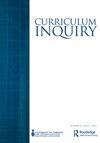Using a Queer of Color Critique to work toward a Black LGBTQ+ inclusive K–12 curriculum
IF 1.6
3区 教育学
Q2 EDUCATION & EDUCATIONAL RESEARCH
引用次数: 1
Abstract
Abstract To date six states (Oregon, California, Colorado, Illinois, Nevada, and New Jersey) have adopted legislation that amends curricular standards to include affirming representations of LGBTQ+ people and identities in schools. Nonetheless, the legislation falls short of clarifying what constitutes an LGBTQ+ inclusive curriculum. Thus, the decision of what to teach is left up to individual districts, schools, and, in many cases, individual teachers who rely on their own interpretations of “positive representation” to adhere to new mandates. In recognizing the negative schooling experiences of Black LGBTQ+ youth, the fact that informal LGBTQ+ curriculum often centers whiteness, and the lack of clarity around what constitutes LGBTQ+ inclusive curricula, in this article I draw on Queer of Color Critique (QOCC) to analyze the practices of ballroom educators and present their approaches to curriculum as a guide to designing LGBTQ+ inclusive curriculum that responds to the realities of Black LGBTQ+ youth. As a framework, QOCC requires researchers to: (a) explore the resilience of queer people of color and their communities as they navigate oppression, (b) rely on the experiential knowledge of queer people of color as a primary source of knowledge production, and (c) examine how queer people of color use their agency to defy the constraints of queer of color marginalization.利用有色酷儿的批评来推动黑人LGBTQ+包容性的K-12课程
迄今为止,俄勒冈州、加利福尼亚州、科罗拉多州、伊利诺伊州、内华达州和新泽西州已经通过立法,修改了课程标准,包括在学校中肯定LGBTQ+人群的代表和身份。尽管如此,这项立法并没有明确什么是LGBTQ+包容性课程。因此,教学内容的决定权留给了各个地区、学校,在许多情况下,还有依靠自己对“积极代表”的理解来遵守新规定的个别教师。认识到黑人LGBTQ+青年的负面教育经历,非正式的LGBTQ+课程往往以白人为中心,以及LGBTQ+包容性课程的缺乏明确性,在这篇文章中,我借鉴了酷儿色彩批判(QOCC)来分析舞厅教育者的做法,并提出了他们的课程方法,作为设计LGBTQ+包容性课程的指南,以回应黑人LGBTQ+青年的现实。作为一个框架,QOCC要求研究人员:(a)探索有色酷儿群体及其社区在面对压迫时的弹性,(b)依靠有色酷儿群体的经验知识作为知识生产的主要来源,(c)研究有色酷儿群体如何利用他们的代理来挑战有色酷儿边缘化的限制。
本文章由计算机程序翻译,如有差异,请以英文原文为准。
求助全文
约1分钟内获得全文
求助全文
来源期刊

Curriculum Inquiry
EDUCATION & EDUCATIONAL RESEARCH-
CiteScore
3.10
自引率
17.60%
发文量
37
期刊介绍:
Curriculum Inquiry is dedicated to the study of educational research, development, evaluation, and theory. This leading international journal brings together influential academics and researchers from a variety of disciplines around the world to provide expert commentary and lively debate. Articles explore important ideas, issues, trends, and problems in education, and each issue also includes provocative and critically analytical editorials covering topics such as curriculum development, educational policy, and teacher education.
 求助内容:
求助内容: 应助结果提醒方式:
应助结果提醒方式:


